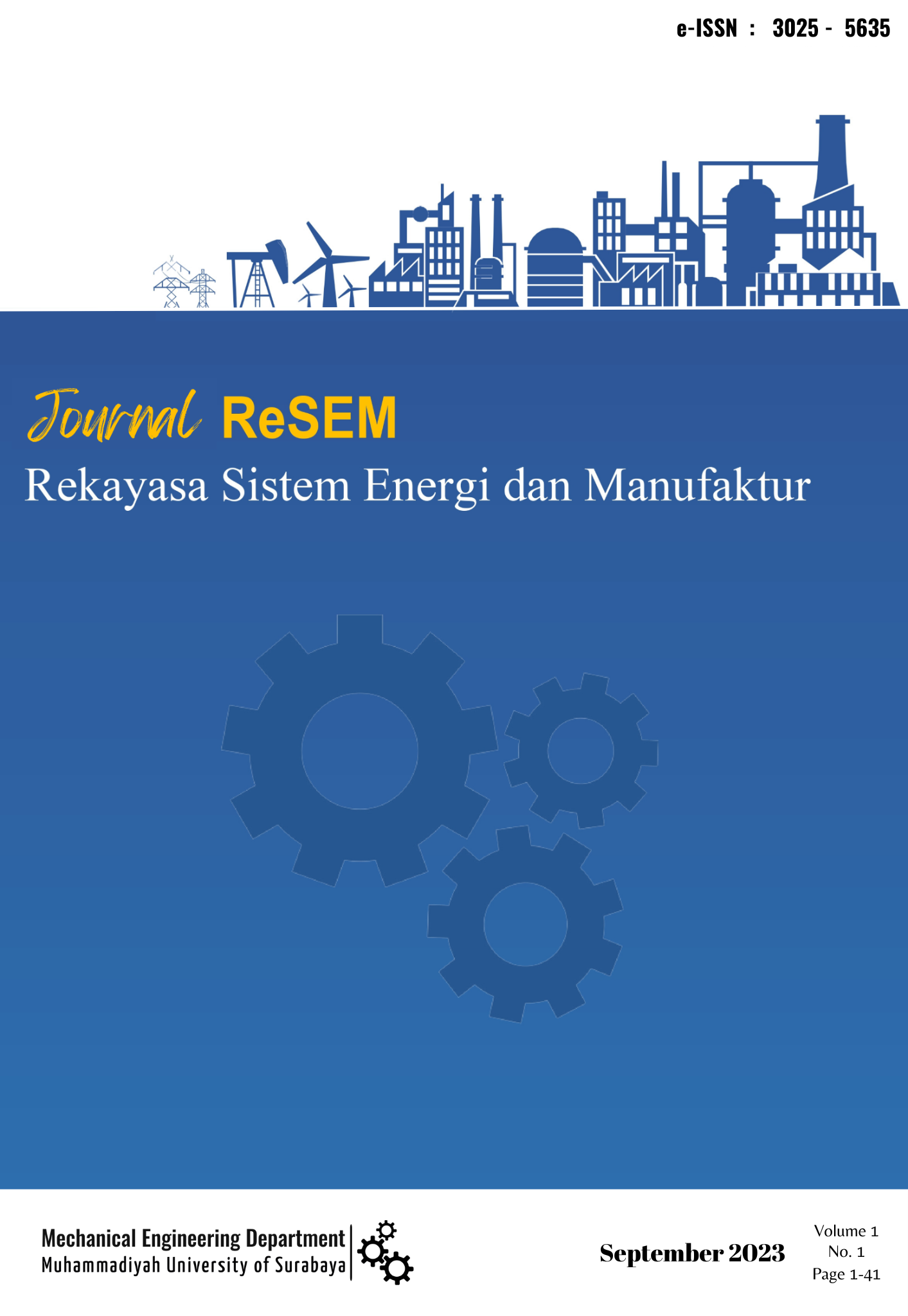PERHITUNGAN BEBAN PENDINGIN PADA GEDUNG TERMINAL 2 BANDAR UDARA INTERNASIONAL JUANDA
DOI:
https://doi.org/10.30651/resem.v1i1.20246Abstrak
Bandar Udara Internasional Juanda menjadi bandar udara tersibuk nomor 2 dengan jumlah pengguna jasa sebesar 4.316.508 jiwa pada tahun 2022 (BPS, 2022). Bertambahnya jumlah pengguna jasa seiring dengan adanya pelonggaran syarat perjalanan udara dapat menyebabkan sering terjadinya komplain dari pengguna jasa terkait suhu udara yang dirasa kurang nyaman pada area terminal. Mengingat pentingnya keberadaan terminal keberangkatan penumpang, ketersediaan fasilitas yang sesuai standar pelayanan juga menjadi poin yang perlu dipertimbangkan. Standar pelayanan yang dimaksudkan meliputi fasilitas keberangkatan dan kedatangan pada sebuah terminal yang mencakup pelayanan calon penumpang dan penumpang di terminal bandar udara. Salah satu fasilitas yang diperhatikan dalam proses keberangkatan dan kedatangan yaitu pengkondisian suhu udara (PM 178 2015) dan ASHARAE. Penulis disini melakukan perhitungan dan Analisa beban pendingin pada Gedung Terminal 2 pada lantai 1 dan latai 2 dengan meliputi 26 area. Setelah dilakukan perhitungan ditemukan beberapa area beban pendingin melebihi dari kapasitas FCU eksisting sebelumnya dengan data sebagai berikut: Imigrasi Kedatangan sesuai perhitungan CLTD 1.183.444 BTU/h sedangkan kapasitas FCU 984.019 BTU/h, POTS sesuai perhitungan CLTD 330.379 BTU/h sedangkan kapasitas FCU 150.000BTU/h, SCP sesuai perhitungan CLTD 424.483 BTU/h sedangkan kapasitas FCU 355.650 BTU/h, RT Gate 1- 6 sesuai perhitungan CLTD 1.638.320 sedangkan kapasitas FCU 1.439.550 BTU/h.
Kata kunci : CLTD, ASHRAE, BTU/h.
Referensi
Sanna Ayu R. 2015. Perhitungan ulang sistem pengkondisian udara pada lantai 3 mall di Surabaya. Surabaya : Tugas Akhir, ITS Surabaya.
Imam Fathoni.2022. Perhitungan Beban Pendingin Pada Lantai 2 Dan 3 Gedung Studio Teras Rumah Di Surabaya Menggunakan Metode CLTD. Surabaya : Skripsi, UM Surabaya.
Fakhrul Fuady. 2017. Evaluasi beban pendingin dan peluang penghematan di lantai IV dan VI Universitas XYZ. Surabaya: Tugas Akhir , ITS Surabaya.
Anugrah Adam A.A. 2018. Evaluasi kebutuhan energi pada sistem pengkondisian udara dan sistem penenerangan untuk lantai 6 dan 7 pada Gedung Pusat Riset ITS. Surabaya : Tugas Akhir, ITS Surabaya
Nur Diniyah Abdi. 2018.Evaluasi Beban Pendinginpada pusat perbelanjaan Trans Studio Mall Makassar. Makasar : Skripsi : Universitas Hasanuddin.
Ashrae. 1997. ASHRAE-HANDBOOK-1997 Fundamental. Atlanta: american society of heating, Refrigeration and air conditioning engineers.
Edward G.Pita. 2002. Air Conditioning principles and systems 4th edition. Prantice Hall.
Hasan A, and Maradu. 2018. Perancangan Air Conditioning (AC) Sentral pada Gedung G Institut Teknologi Indonesia. Tangerang selatan : Jurnal ITI.
Juni Handoko. 2008. Merawat & Memperbaiki AC. Jakarta Selatan: PT. Kawan Pustaka.
Lukito, D.Y and Eko, B. 2021. Teknik dasar perawatan air conditioner (AC). Lampung: CV. Laduny Alifatama
Syamsuri Hasan dkk. 2008. Sisitem refrigerasi dan tata udara jilid 1. Jakarta : Direktorat
Pembinaan Sekolah Menengah Kejuruan
W.F. Stoecker, and J.W. Jones. 1962. Refrigeration and air conditioning 2nd edition. McGraw- Hill Inc.
Yasmirja, H. N. 2017. Perencanaan dan pemasangan air conditioning pada ruang dosen dan teknisi PSD III Teknik Mesin Universitas Diponegoro Semarang. Semarang : Skripsi, Universitas Diponegoro Semarang.
Saghifa Fitriana. 2019. Analisis menentukan rekomendasi penyejuk udara yang tepat menggunakan metode moora. Jakarta : Jurnal STMIK Nusa Mandiri Jakarta.
Muhammad Bintang F. 2016. Perencanaan ulang sistem pengondisian udara pada lantai II Mall “XYZ” Di Kediri. Surabaya: Tugas Akhir , ITS Surabaya.









